Erebia
Erebia is a Holarctic genus of brush-footed butterflies, family Nymphalidae. Most of the about 90–100 species (see also below) are dark brown or black in color, with reddish-brown to orange or more rarely yellowish wing blotches or bands. These usually bear black spots within, which sometimes have white center spots.
| Erebia | |
|---|---|
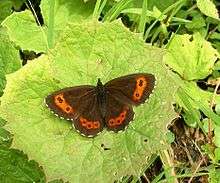 | |
| Arran brown (type species) | |
| Scientific classification | |
| Kingdom: | Animalia |
| Phylum: | Arthropoda |
| Class: | Insecta |
| Order: | Lepidoptera |
| Family: | Nymphalidae |
| Subtribe: | Erebiina |
| Genus: | Erebia Dalman, 1816 |
| Type species | |
| Papilio ligea Linnaeus, 1758 | |
| Diversity | |
| Around 100 species | |
| Synonyms | |
|
Atercoloratus Bang-Haas, 1938 | |
_male_Bulgaria.jpg)
_female_Bulgaria_2.jpg)
_underside_Bulgaria.jpg)
_Bulgaria.jpg)
_underside_Bulgaria_3.jpg)
This genus has found it easy to adapt to arid and especially cold conditions. Most of its members are associated with high-altitude lands, forest clearings or high latitude and tundra. Erebia species are frequent in the Alps, Rocky Mountains, subarctic and even Arctic regions, and the cooler parts of Central Asia. In fact, the North American term for these butterflies is alpines. Eurasian species are collectively known as ringlets or arguses. However, none of these terms is used exclusively for this genus.
Taxonomy and systematics
The genus Erebia was erected by Johan Wilhelm Dalman in 1816. As type species, the Arran brown—described as Papilio ligea by Carl Linnaeus in 1758—was chosen. This is a very complex genus with over 1300 taxa, but a massive proportion of these are junior synonyms. Some of the available names are listed by Vladimir Lukhtanov.[1] A fully comprehensive taxonomic checklist (i.e., without discussing synonymy and relationships) was published in 2008.[2]
Only three years after the genus' inception, the known species were reviewed by Jacob Hübner.[3] He established no less than five new genera for a fraction of what would eventually be named as "species" of Erebia. But things hardly improved as more and more of the diversity of these butterflies came to note. In Europe, a large number of Erebia taxa was described from the Alps. In the 19th and early 20th century the Alps were a popular destination for butterfly collectors and specimens of Alpine butterflies were very profitable for dealers. The dealers, mostly German, not only sold specimens, but were entomologists, entomological book dealers, entomological authors and publishers. Examples are Fritz Rühl, Alexander Heyne, Otto Staudinger, Andreas and Otto Bang-Haas and, in Paris, Achille and Émile Deyrolle.
This, together with the then-popular, even obsessive study of variation by entomologists – examples are James William Tutt, George Wheeler, Felix Bryk and Brisbane Charles Somerville Warren – led to very many names being applied to what may be or much more likely may not be biological species or subspecies. A further problem is the use of the term "variety". Authors of that time used this for an individual variant, a group of individuals morphologically but not otherwise related, seasonal forms, temperature-related forms, or geographic races; it was later usually taken to mean the last subspecies though this is often suspected to have been premature.
Eventually, it became common to arrange supposed species and subspecies to "species groups" (not superspecies, but an informal phenetic arrangement) as pioneered by B.C.S. Warren,[4] and attempt to resolve their true nature by and by. As molecular phylogenetic studies add to the available data, it is becoming clear that most "varieties" that have at least been commonly considered subspecies in the latter 20th century are indeed lineages distinct enough to warrant some formal degree of recognition. Another result of recent research is confirmation of the theory that this genus contains many glacial relict taxa, e.g., in the brassy ringlet group (E. tyndarus and similar species).[5]
The number of currently recognized Erebia species is given variously around 90-100, as developments happen so fast that it is hard for authors to remain up to date regarding the newest changes.[5]
Species list
As of early 2008, the following good species and some rather distinct subspecies are listed:[6]
- Erebia aethiopella (Hoffmannsegg, 1806) – false Mnestra ringlet
- Erebia aethiops (Esper, 1777) – Scotch argus
- Erebia ajanensis Ménétriés, 1857
- Erebia alberganus (Prunner, 1798) – almond ringlet or almond-eyed ringlet
- Erebia alcmena Grum-Grshimailo, 1891
- Erebia alini (Bang-Haas, 1937) (disputed)
- Erebia anyuica Kurenzov, 1966 – scree alpine
- Erebia arctica R.Poppius, 1906
- Erebia atramentaria O.Bang-Haas, 1927
- Erebia calcaria Lorković, 1949 – Lorkovic's brassy ringlet
- Erebia callias Edwards, 1871
- Erebia (callias) altajana Staudinger, 1901
- Erebia (callias) callias – Colorado alpine
- Erebia (callias) sibirica Staudinger, 1881
- Erebia (callias) simulata Warren, 1933
- Erebia cassioides (Reiner & Hohenwarth, 1792) – common brassy ringlet
- Erebia (cassioides) arvernensis Oberthür 1908 – western brassy ringlet
- Erebia (cassioides) carmenta Fruhstorfer, 1907 – western brassy ringlet
- Erebia (cassioides) macedonica Buresch, 1918
- Erebia christi Rätzer, 1890 – Raetzer's ringlet
- Erebia claudina (Borkhausen, 1789) – white speck ringlet
- Erebia cyclopius (Eversmann, 1844)
- Erebia dabanensis Erschoff, 1871
- Erebia disa (Thunberg, 1791) – Arctic ringlet or disa alpine
- Erebia discoidalis Kirby, 1837 – red-disked alpine
- Erebia dromulus Staudinger, 1901
- Erebia edda Ménétriés, 1851
- Erebia embla (Thunberg, 1791) – Lapland ringlet
- Erebia epiphron (Knoch, 1783) – mountain ringlet or small mountain ringlet
- Erebia epipsodea Butler, 1868 – common alpine
- Erebia epistygne (Hübner, 1819) – spring ringlet
- Erebia erinnyn Warren, 1932
- Erebia eriphyle (Freyer, 1836) – eriphyle ringlet
- Erebia eugenia Churkin, 2000
- Erebia euryale (Esper, 1805) – large ringlet
- Erebia fasciata Butler, 1868 – banded alpine
- Erebia flavofasciata Heyne, 1895 – yellow-banded ringlet
- Erebia fletcheri Elwes, 1899
- Erebia gorge (Esper, 1805) – silky ringlet
- Erebia gorgone – Gavarnie ringlet
- Erebia graucasica Jachontov, 1909
- Erebia haberhaueri Staudinger, 1881
- Erebia hewitsoni Lederer, 1864
- Erebia hispania Butler, 1868 – Spanish brassy ringlet
- Erebia inuitica Wyatt, 1966 (disputed)
- Erebia iranica Grum-Grshimailo, 1895
- Erebia jeniseiensis Trybom, 1877
- Erebia kalmuka Alphéraky, 1881
- Erebia kefersteini (Eversmann, 1851)
- Erebia kindermanni Staudinger, 1881
- Erebia kozhantshikovi Sheljuzhko, 1925
- Erebia lafontainei (Troubridge & Philip, 1983) – reddish alpine
- Erebia lefebvrei (Boisduval, [1828]) – Lefèbvre's ringlet
- Erebia ligea (Linnaeus, 1758) – Arran brown
- Erebia mackinleyensis (Gunder, 1932) – Mt. McKinley alpine
- Erebia magdalena Strecker, 1880 – Magdalena alpine
- Erebia mancinus Doubleday, [1849] – taiga alpine
- Erebia manto ([Schiffermüller], 1775) – yellow-spotted ringlet
- Erebia maurisius Lukhtanov & Lukhtanov, 1994 (might be Erebia brimo (Böber, 1809))
- Erebia medusa (Denis & Schiffermüller, 1975) – woodland ringlet
- Erebia medusa polaris Staudinger, 1871 – Arctic woodland ringlet
- Erebia melampus (Fuessli, 1775) – lesser mountain ringlet
- Erebia melancholica Herrich-Schäffer, [1846]
- Erebia melas (Herbst, 1796) – black ringlet
- Erebia meolans (Prunner, 1798) – Piedmont ringlet
- Erebia meta Staudinger, 1886
- Erebia mnestra (Hübner, [1803-1804]) – Mnestra's ringlet
- Erebia montana (de Prunner, 1798) – marbled ringlet
- Erebia neoridas (Boisduval, [1828]) – autumn ringlet
- Erebia neriene (Böber, 1809)
- Erebia niphonica Janson, 1877
- Erebia nivalis Lorković & Lesse, 1954 – de Lesse's brassy ringlet
- Erebia occulta Roos & Kimmich, 1983 – Eskimo alpine
- Erebia ocnus (Eversmann, 1843)
- Erebia oeme (Hübner, [1803-1804]) – bright-eyed ringlet
- Erebia orientalis Elwes, 1900
- Erebia ottomana Herrich-Schäffer, [1851] – Ottoman brassy ringlet
- Erebia (ottomana) benacensis Warren, 1933
- Erebia palarica Chapman, 1905 – Chapman's ringlet
- Erebia pandrose (Borkhausen, 1788) – dewy ringlet
- Erebia pawlowskii Ménétriés, 1859 – yellow-dotted alpine or Theano alpine[7]
- Erebia pharte (Hübner, [1803-1804]) – blind ringlet
- Erebia pluto (de Prunner, 1798) – sooty ringlet
- Erebia progne Grum-Grshimailo, 1890
- Erebia pronoe (Esper, 1780) – water ringlet
- Erebia radians Staudinger, 1886
- Erebia rhodopensis Nicholl, 1900 - Nicholl's ringlet
- Erebia rondoui Oberthür 1908 (previously in E. cassioides)
- Erebia rossii (Curtis, 1835) – Arctic–alpine or Ross's alpine
- Erebia rurigena (disputed)
- Erebia sachaensis Dubatolov, 1992
- Erebia scipio Boisduval, 1832 – larche ringlet
- Erebia serotina Descimon & de Lesse, 1953 – Descimon's ringlet
- Erebia sibo (Alphéraky, 1881)
- Erebia sokolovi Lukhtanov, 1990
- Erebia sthennyo Graslin, 1850 – false dewy ringlet
- Erebia stirius (Godart, [1824]) – Styrian ringlet
- Erebia stubbendorfii Ménétriés, 1846
- Erebia styx (Freyer, 1834) – Stygian ringlet
- Erebia sudetica Staudinger, 1861 – Sudeten ringlet
- Erebia theano (Tauscher, 1806) – Theano alpine
- Erebia tianschanica Heyne, [1894]
- Erebia transcaucasica Warren, 1950 (previously in E. graucasica)
- Erebia triarius (de Prunner, 1798) – de Prunner's ringlet
- Erebia troubridgei (Dubatolov, 1992)
- Erebia turanica Erschoff, [1877]
- Erebia tyndarus (Esper, 1781) – Swiss brassy ringlet
- Erebia usgentensis Heyne, [1894]
- Erebia vidleri Elwes, 1898 – northwest alpine or Vidler's alpine
- Erebia wanga Bremer, 1864
- Erebia youngi Holland, 1900 – Yukon alpine or four-dotted alpine
- Erebia zapateri Oberthür, 1875 – Zapater's ringlet
Gallery
 First of the three Erebia plates in the 1915 Macrolepidoptera of the World, edited by Adalbert Seitz. This work was published near the height of taxonomic confusion about these butterflies.
First of the three Erebia plates in the 1915 Macrolepidoptera of the World, edited by Adalbert Seitz. This work was published near the height of taxonomic confusion about these butterflies. Another Macrolepidoptera of the World plate, showing larger species.
Another Macrolepidoptera of the World plate, showing larger species.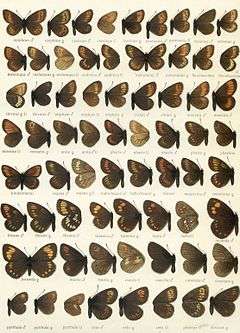 Third Macrolepidoptera of the World plate, of the 31 named taxa depicted, probably less than 10 are actual species.
Third Macrolepidoptera of the World plate, of the 31 named taxa depicted, probably less than 10 are actual species.
Erebia comparison

.jpg)
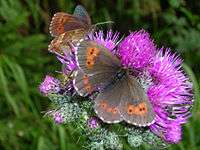

 Erebia aethiops
Erebia aethiops.jpg) Erebia aethiops
Erebia aethiops Erebia aethiops
Erebia aethiops
underside ♂ Erebia aethiops
Erebia aethiops
underside ♀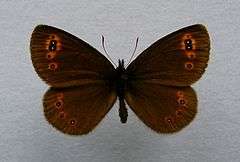

.jpg)
- Erebia neoridas
 Erebia meolans
Erebia meolans Erebia meolans
Erebia meolans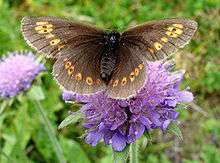
 Erebia alberganus
Erebia alberganus
underside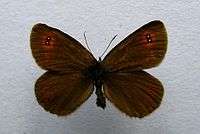 Erebia oeme ♂
Erebia oeme ♂ Erebia oeme ♀
Erebia oeme ♀ Erebia oeme
Erebia oeme
underside ♂ Erebia oeme
Erebia oeme
underside ♀ Erebia pronoe
Erebia pronoe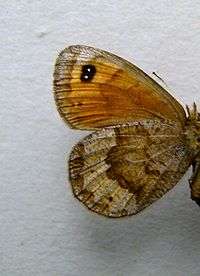 Erebia pronoe
Erebia pronoe
underside ♀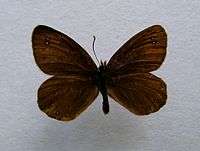 Erebia pluto
Erebia pluto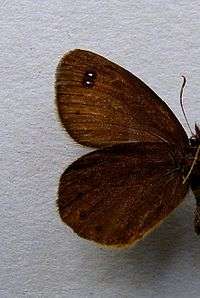 Erebia pluto
Erebia pluto
underside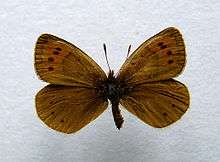
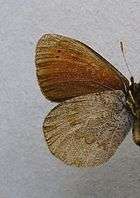 Erebia pandrose
Erebia pandrose
underside Erebia stirius
Erebia stirius Erebia stirius
Erebia stirius
underside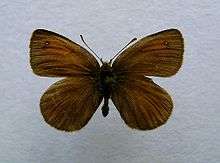
 Erebia nivalis
Erebia nivalis
underside Erebia manto ♂
Erebia manto ♂ Erebia manto
Erebia manto
underside ♀ Erebia gorge
Erebia gorge Erebia gorge f. triopes
Erebia gorge f. triopes Erebia gorge f. erynis
Erebia gorge f. erynis Erebia gorge
Erebia gorge
underside Erebia tyndarus
Erebia tyndarus
underside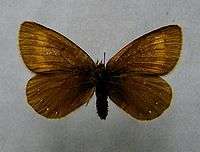 Erebia claudina
Erebia claudina Erebia claudina
Erebia claudina
underside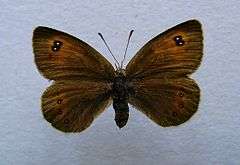
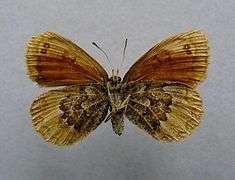 Erebia cassioides
Erebia cassioides
underside ♀
 Erebia pharte
Erebia pharte
underside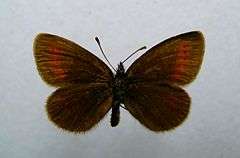
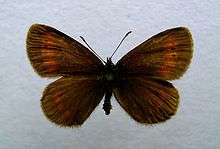 Erebia sudetica
Erebia sudetica Erebia mnestra
Erebia mnestra Erebia mnestra
Erebia mnestra
underside Erebia christi
Erebia christi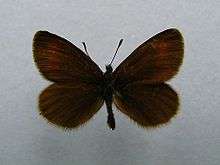 Erebia eryphile
Erebia eryphile Erebia zapateri
Erebia zapateri Erebia episodea
Erebia episodea- Erebia flavofasciata
- Erebia gorgone
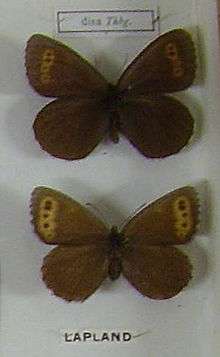 Erebia disa
Erebia disa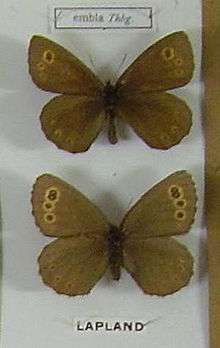 Erebia embla
Erebia embla
See also
- Other Lepidoptera genera with excessive named taxa:
- Species concept
Footnotes
- Lukhtanov [2008]
- Tennent (2008)
- Hübner [1819]
- Warren (1936)
- Albre et al. (2008)
- Brower (2006), Albre et al. (2008), and see Savela (2008) for more sources
- Brock, Jim P. and K. Kaufman (2003). Kaufman Field Guide to Butterflies of North America. New York, NY:Houghton Mifflin.
References
- Albre, Jerome; Gers, Charles & Legal, Luc (2008). Molecular phylogeny of the Erebia tyndarus (Lepidoptera, Rhopalocera, Nymphalidae, Satyrinae) species group combining CoxII and ND5 mitochondrial genes: A case study of a recent radiation. Mol. Phylogenet. Evol. 47(1): 196–210. doi:10.1016/j.ympev.2008.01.009 (HTML abstract)
- Brower, Andrew V.Z. (2006). Tree of Life Web Project - Erebia. Version of November 28, 2006. Retrieved August 11, 2008.
- Hübner, Jacob [1819]. [Several new genera for Erebia]. In: Verzeichniss bekannter Schmettlinge [sic] (Vol.4): 62-64.
- Lukhtanov, Vladimir [2008]. Palaearctic Butterfly Checklist - Nymphalidae: Satyrinae. Version of February 4, 2008. Retrieved August 11, 2008.
- Savela, Markku (2008). Markku Savela's Lepidoptera and Some Other Life Forms - Erebia. Version of march 15, 2008. Retrieved 11 August 2008.
- Tennent, W. John (2008). A checklist of the satyrine genus Erebia (Lepidoptera) (1758–2006). Zootaxa 1900: 1-109. PDF contents, abstract and first page text
- Warren, Brisbane Brisbane Charles Somerville (1936). Monograph of the genus Erebia. British Museum of Natural History, London.
External links
| Wikimedia Commons has media related to: |
| Wikispecies has information related to Erebia |
- Nearctica Images of some Nearctic species.
- Nearctic species
- European species
- Rusinsects Former U.S.S.R. Erebia photographs, accurate text.
- Kulfan pdf Erebia fauna of the Tatras
- Zipcode Zoo
- Pdf from Nagy et al. Alpine Biodiversity in Europe (Arctic–Alpine Butterflies).
- Flickr images